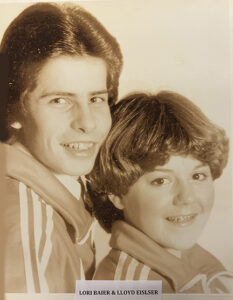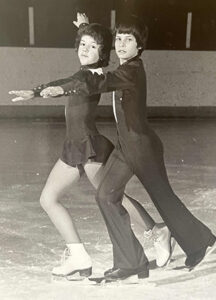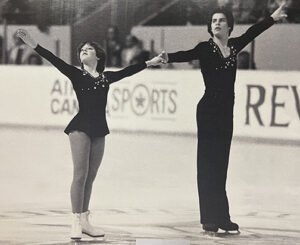
When Mitchell’s Lorri Baier and Seaforth’s Lloyd Eisler were first paired together in 1973, the two were so young that they would not hold hands, as Eisler recalls, “because I was afraid of Lorri.”
“We grew up together,” said Baier. They began skating together under Kerry Leitch at the Preston Figure Skating Club when they were nine. The two were exactly the same weight and Lloyd was unable to lift Lorri above his head.
“When we won the Canadian Championships at the Novice Level we had one overhead lift and a HUGE throw— a double axel which was pretty amazing back then for such young skaters.”
The following year in Junior they had to do the required lift standing still at the beginning of their program because Lloyd was still not strong enough to lift Lorri.
“That all changed in one year when I grew 10 inches and gained about 60 lbs.,” recalled Lloyd, who eventually became known throughout the figure skating world for his lifts.
“When we started skating together I didn’t know what we were in for,” said Lorri, “but as the time went on, I found I really enjoyed the athletic, thrilling part of pair skating. Herb was a great partner because it was really easy for us to be in unison.”

In 1978 Baier and Eisler were silver medalists in Junior Pairs competition at the Canadian Figure Skating Championships. That same year Lorri’s sister Sherri Baier and partner Robin Cowan won the national championships. Both partners skated singles as well as pairs in the early yers, with Baier winning the Novice Canadian championship one year, and went to the World Juniors as a singles skater.
A year after earning silver at the Canadian Junior Pairs Championships, Baier and Eisler won gold at the Canadian championships in 1979 and went on to win bronze at the World Junior Figure Skating Championships.
“I very much remember our first Senior Championships in 1980,” said Eisler, “and we skated amazing, but came second, and it was disappointing because many people thought we should have won and we would have gone to the 1980 Olympics. This event was in Kitchener so very close to home and all our family was there to watch.”
They were second to Barbara Underhill and Paul Martini.
They followed their silver at the senior pairs championships by winning gold in England and silver at their final World Junior Figure Skating Championships.
Also in 1981 they finished ninth at the World Pairs Figure Skating Championships and earned a Cambridge athlete of the year nomination once again.
“Lorri was the strongest female pair skater—both physically and mentally—that I trained,” said Leitch, who coached a number of Canadian and international medalists through one of the most distinguished coaching careers in Canadian history.
But Lloyd, whose nickname was Herb, was also a rare skater. “He was the best competitor and performer under pressure that I taught,” said Leitch.

Leitch likens the ups and downs of pairs figure skating to a marriage. “Lorri was the boss of the team and as in any successful marriage, Lorri made Herb think he was the boss but everyone knew the obvious.”
Lloyd agrees. “Lorri was always incredibly creative and seemed to be the glue that kept our team together,” said Eisler. “I was more of the bull in a china shop type of skater.”
Together they spent many hours driving back and forth from Seaforth and Mitchell to Preston to skate under coach Leitch. “That’s where most, and sometimes all, of our homework was done, in the car.” They travelled a lot of miles back and forth from Mitchell to Preston. Lloyd turned 16 first, and got his license, and then Lorri got hers and that took some of the load off their parents.
Together, they invented a pair spin called the Herbie/Lorri spin, which happened by accident.
“I was working with them on a pair spin,” recalled Leitch, “and Herb was experiencing great difficulty doing the position I wanted. He kept saying that it would be easier to grab her around the waist and go into a sit spin which I pointed out was impossible and he quickly proved me wrong and the new spin was invented.”
Lloyd recalled Lorri as being “the one with the very level head and one to always question why things needed to be done.”
They were also the first team in the world to perform back-to-back Throw Double Axels in a competition.
Leitch coached a string of highly successful pairs skaters, including Lorri’s older sister, Sherri Baier (Phelan) and Robin Cowan, who won the Canadian novice pairs title in 1975, then won the Canadian Juniors the following year, also capturing the World Junior Pairs title. In 1977 Paul Mills and Josie France (Jamieson) burst on the international scene capturing the junior world title.
It was through Sherri that Lorri started skating at Preston. “I was always just tagging along with mum and Sherri,” recalled Lorri.
Lorri and Herb had success from an early age, and although they skated together for a decade, their time together as a pairs team, said Eisler, came too soon. “We finished our career in Copenhagen at the World Championships in 1982. It was a tough thing because I always thought we would continue skating forever, but nothing lasts forever.” Lorri, said Eisler, “always had bigger aspirations than just skating.”
Their families had become close, and given that they lived not far apart, they did a lot of things together. “And the towns of Seaforth and Mitchell were so incredibly supportive,” said Eisler. “It was home for us. We always lived there until we retired. And Lorri’s parents, Donna and Murray, “were great people and always there for us.”
After Lorri retired, Lloyd continued to skate, and two years later, with his new partner Katherina Matousek, finished 10th at the Worlds, while Preston teammates Cynthia Coull and Mark Rowsom were ninth. Eisler and Matousek finished eighth at the 1984 Olympics while Melinda Kunhegyi and Lyndon Johnston were 12th.
Eisler and Matousek continued to improve, capturing a bronze medal at Worlds in 1985.
Preston teammates Coull and Rowsom finished skating together with a bronze medal at the 1986 World Championships.
Lorri, after retiring, went on to have a highly successful teaching and coaching career in Denmark and later in Canada.
Lloyd continued his pairs skating success–after skating with Kathy Matousek—he paired finally with Isabel Brasseur. The pair won bronze medals at both the 1992 and 1994 Olympics and were the 1993 world champions.
After almost half a century since they began skating together, both the New Jersey-based Lloyd, who is married to actress Kristy Swanson and operates one of the premier power skating schools for hockey players in the USA, and Lorri, who lives in Kitchener, remain good friends.
